Geomagnetic storms begin as potent coronal hole becomes geoeffective
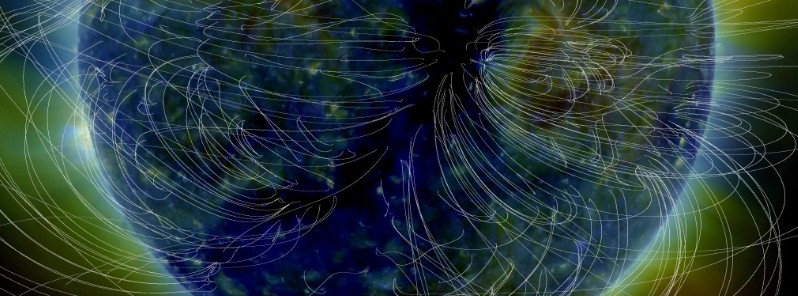
A recurrent, negative-polarity coronal hole is affecting our planet, causing geomagnetic storming. A G2 – Moderate geomagnetic storm watch is in effect for March 28 and 29.
A high speed solar wind stream produced by a recurrent, negative-polarity (potent) coronal hole is becoming geoeffective today and forecasters expect G2 – Moderate geomagnetic storms to begin on March 28 and continue through March 29.
Geomagnetic K-index of 5 threshold (G1 – Minor geomagnetic storm) was first reached at 05:59 UTC today.
"Solar wind parameters are expected to be enhanced over the next three days (March 27 – 29) due to the onset of a CIR [co-rotating interaction region / interaction between fast and slow streams] followed by the influence of a recurrent, negative polarity CH HSS," SWPC said and added that recurrence and STEREO-A data suggest solar wind speeds in the 650 – 700 km/s range are likely during the passage of this feature.
"This coronal hole feature produced G2 – Moderate storm conditions during its last rotation and is expected to impact the Earth's magnetosphere in a similar manner," the center said.
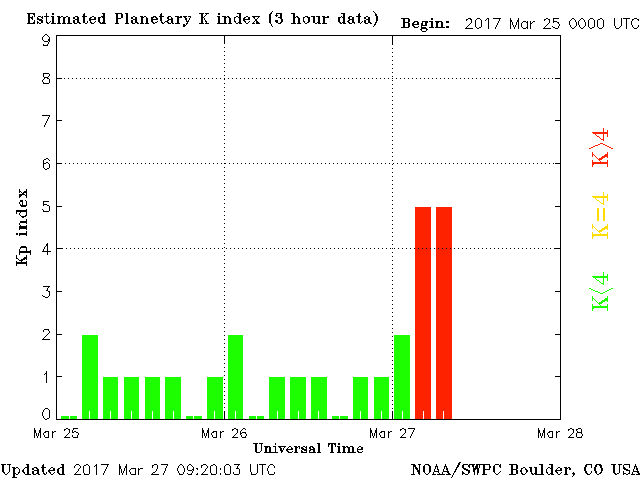
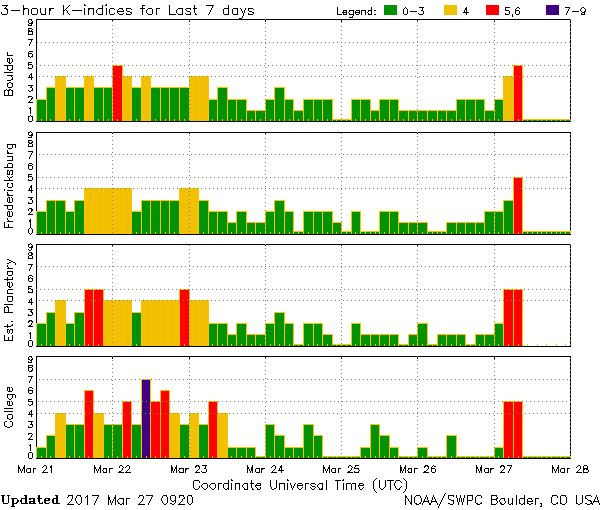
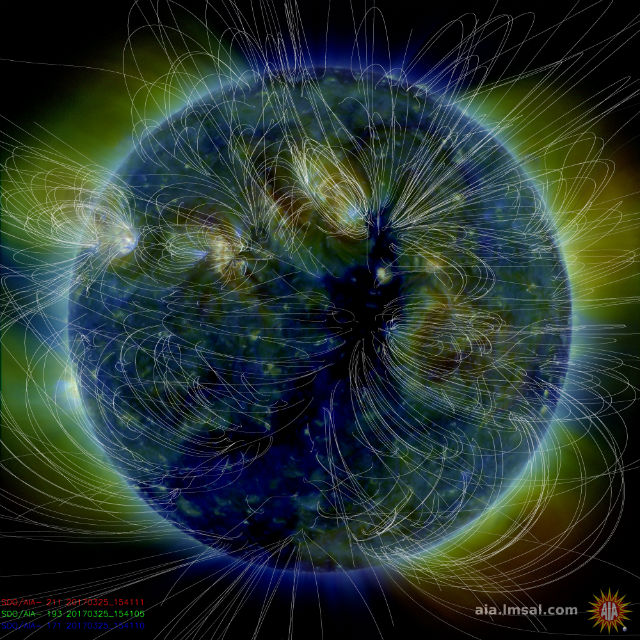
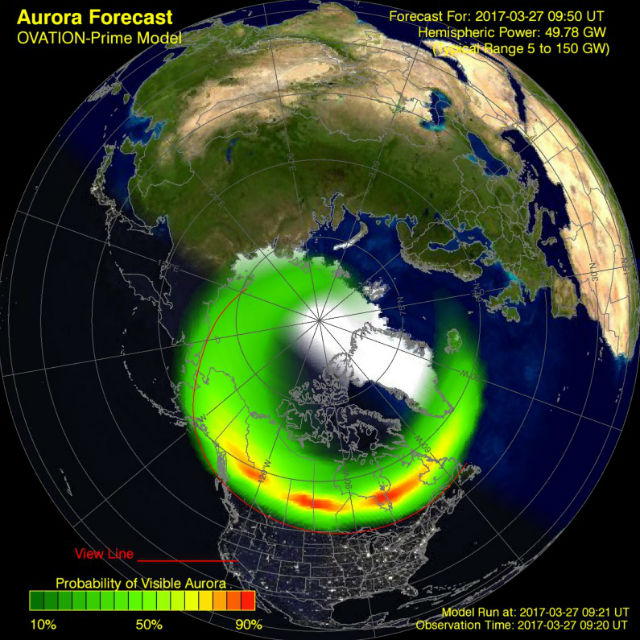
Meanwhile, solar activity is very low, but there is one interesting beta region on the Earth-facing side of the Sun – AR2644 – which is producing multiple B-class solar flares. On March 26, it produced five B and one C-class. None of them appear to be Earth-directed.
Solar activity is expected to continue at very low levels with only a slight chance for C-class flare activity over the next three days. An emerging area of sunspots is rotating into view but it is yet to be numbered.
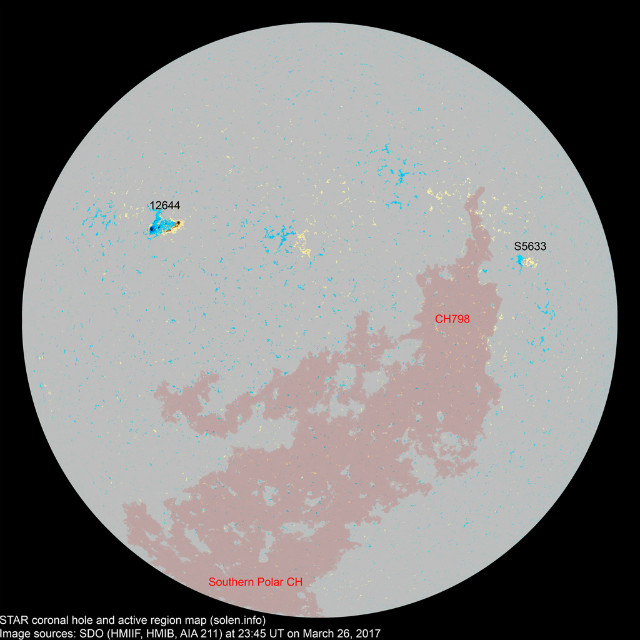
Updates
10:24 UTC
G2 geomagnetic storm
Geomagnetic K-index of 6 threshold (G2 – Moderate geomagnetic storm) was reached at 10:24 UTC.
Area of impact is primarily poleward of 55 degrees Geomagnetic Latitude.
Under G2 conditions, power grid fluctuations can occur, high-latitude power systems may experience voltage alarms. Satellite orientation irregularities may occur and increased drag on low Earth-orbit satellites is possible. HF (high frequency) radio propagation can fade at higher latitudes. Aurora may be seen as low as New York to Wisconsin to Washington state.
SWPC Alerts, Watches and Warnings
Space Weather Message Code: ALTK06
Serial Number: 425
Issue Time: 2017 Mar 27 1024 UTC
ALERT: Geomagnetic K-index of 6
Threshold Reached: 2017 Mar 27 1024 UTC
Synoptic Period: 0900-1200 UTC
Active Warning: Yes
NOAA Scale: G2 – Moderate
NOAA Space Weather Scale descriptions can be found at
www.swpc.noaa.gov/noaa-scales-
Potential Impacts: Area of impact primarily poleward of 55 degrees Geomagnetic Latitude.
Induced Currents – Power grid fluctuations can occur. High-latitude power systems may experience voltage alarms.
Spacecraft – Satellite orientation irregularities may occur; increased drag on low Earth-orbit satellites is possible.
Radio – HF (high frequency) radio propagation can fade at higher latitudes.
Aurora – Aurora may be seen as low as New York to Wisconsin to Washington state.
***
Space Weather Message Code: ALTK05
Serial Number: 1078
Issue Time: 2017 Mar 27 0740 UTC
ALERT: Geomagnetic K-index of 5
Threshold Reached: 2017 Mar 27 0735 UTC
Synoptic Period: 0600-0900 UTC
Active Warning: Yes
NOAA Scale: G1 – Minor
NOAA Space Weather Scale descriptions can be found at
www.swpc.noaa.gov/noaa-scales-explanation
Potential Impacts: Area of impact primarily poleward of 60 degrees Geomagnetic Latitude.
Induced Currents – Weak power grid fluctuations can occur.
Spacecraft – Minor impact on satellite operations possible.
Aurora – Aurora may be visible at high latitudes, i.e., northern tier of the U.S. such as northern Michigan and Maine.
***
Space Weather Message Code: ALTK05
Serial Number: 1077
Issue Time: 2017 Mar 27 0559 UTC
ALERT: Geomagnetic K-index of 5
Threshold Reached: 2017 Mar 27 0559 UTC
Synoptic Period: 0300-0600 UTC
Active Warning: Yes
NOAA Scale: G1 – Minor
NOAA Space Weather Scale descriptions can be found at
www.swpc.noaa.gov/noaa-scales-explanation
Potential Impacts: Area of impact primarily poleward of 60 degrees Geomagnetic Latitude.
Induced Currents – Weak power grid fluctuations can occur.
Spacecraft – Minor impact on satellite operations possible.
Aurora – Aurora may be visible at high latitudes, i.e., northern tier of the U.S. such as northern Michigan and Maine.
***
Space Weather Message Code: WARK05
Serial Number: 1327
Issue Time: 2017 Mar 27 0520 UTC
WARNING: Geomagnetic K-index of 5 expected
Valid From: 2017 Mar 27 0520 UTC
Valid To: 2017 Mar 27 1500 UTC
Warning Condition: Onset
NOAA Scale: G1 – Minor
NOAA Space Weather Scale descriptions can be found at
www.swpc.noaa.gov/noaa-scales-explanation
Potential Impacts: Area of impact primarily poleward of 60 degrees Geomagnetic Latitude.
Induced Currents – Weak power grid fluctuations can occur.
Spacecraft – Minor impact on satellite operations possible.
Aurora – Aurora may be visible at high latitudes, i.e., northern tier of the U.S. such as northern Michigan and Maine.
***
Space Weather Message Code: ALTK04
Serial Number: 1966
Issue Time: 2017 Mar 27 0500 UTC
ALERT: Geomagnetic K-index of 4
Threshold Reached: 2017 Mar 27 0459 UTC
Synoptic Period: 0300-0600 UTC
Active Warning: Yes
NOAA Space Weather Scale descriptions can be found at
www.swpc.noaa.gov/noaa-scales-explanation
Potential Impacts: Area of impact primarily poleward of 65 degrees Geomagnetic Latitude.
Induced Currents – Weak power grid fluctuations can occur.
Aurora – Aurora may be visible at high latitudes such as Canada and Alaska.
***
Space Weather Message Code: WARK04
Serial Number: 3177
Issue Time: 2017 Mar 27 0351 UTC
WARNING: Geomagnetic K-index of 4 expected
Valid From: 2017 Mar 27 0350 UTC
Valid To: 2017 Mar 27 2359 UTC
Warning Condition: Onset
NOAA Space Weather Scale descriptions can be found at
www.swpc.noaa.gov/noaa-scales-explanation
Potential Impacts: Area of impact primarily poleward of 65 degrees Geomagnetic Latitude.
Induced Currents – Weak power grid fluctuations can occur.
Aurora – Aurora may be visible at high latitudes such as Canada and Alaska.
***
Space Weather Message Code: WATA30
Serial Number: 151
Issue Time: 2017 Mar 26 1902 UTC
WATCH: Geomagnetic Storm Category G2 Predicted
Highest Storm Level Predicted by Day:
Mar 27: G1 (Minor) Mar 28: G2 (Moderate) Mar 29: G2 (Moderate)
THIS SUPERSEDES ANY/ALL PRIOR WATCHES IN EFFECT
NOAA Space Weather Scale descriptions can be found at
www.swpc.noaa.gov/noaa-scales-explanation
Potential Impacts: Area of impact primarily poleward of 55 degrees Geomagnetic Latitude.
Induced Currents – Power grid fluctuations can occur. High-latitude power systems may experience voltage alarms.
Spacecraft – Satellite orientation irregularities may occur; increased drag on low Earth-orbit satellites is possible.
Radio – HF (high frequency) radio propagation can fade at higher latitudes.
Aurora – Aurora may be seen as low as New York to Wisconsin to Washington state.
Featured image: Coronal hole on March 25, 2017. Credit: NASA SDO/AIA, LMSAL

Commenting rules and guidelines
We value the thoughts and opinions of our readers and welcome healthy discussions on our website. In order to maintain a respectful and positive community, we ask that all commenters follow these rules.